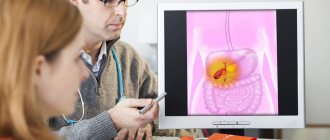This site was made by experts: toxicologists, narcologists, hepatologists. Strictly scientific. Tested experimentally.
Author of this article, expert: gastroenterologist Daniela Sergeevna Purgina
In short: Gallbladder shutdown may be temporary if the situation can be corrected. But if the gallbladder has shut down completely, then there is only one solution: removal of the organ. All the same, it no longer fulfills its functions, but only serves as a dangerous source of inflammation in the body.
- Disabled gallbladder, what does it mean?
- Why can this happen?
- How does this condition manifest?
- How does a doctor notice a disabled gallbladder?
- How to treat?
- What awaits the patient?
- How to avoid gallbladder shutdown
This article was edited by gastroenterologist Daniela Sergeevna Purgina.
Disabled gallbladder, what does it mean?
The gallbladder in the body of a healthy person performs the function of storing and concentrating bile. However, sometimes there are situations in which the gallbladder ceases to perform its functions.
A disabled gallbladder is a condition in which it stops contracting and bile does not flow into the duodenum in sufficient quantities to ensure adequate digestion.
A disabled gallbladder is most often a complication of gallstone disease, rather than an independent disease. Bile itself is produced by hepatocytes (liver cells) and is excreted into the gallbladder using the bile ducts. And if the bladder does not function, then difficulty arises in the outflow of bile.
Most often, the gallbladder shuts down when there are stones in it. The space that should be filled with bile, accumulated for the next release into the duodenum, is gradually filled with gallstones.
The state of a disabled gallbladder can be permanent or temporary. If it is reversible, then doctors call it temporary. In this case, performance will be restored if the negatively influencing factors are eliminated: for example, if the stone that blocked the bile duct moves or comes out.
Diet
Nutritional adjustments are prescribed for any type of treatment: for surgical treatment - immediately after the operation, for medication - from the moment you start taking medications. Its main principles are:
- eat 4-5 times a day in small portions (200-300 g at a time);
- Dishes are allowed boiled, stewed, baked, fried is prohibited;
- animal fats are limited;
- Only low-fat varieties of meat and fish are allowed;
- for the first time after surgery or during drug treatment, all food should be of liquid or semi-liquid consistency;
- The amount of salt and sugar consumed is limited.
Fast food, processed foods, and other harmful products are prohibited for life.
Until the acute stage of cholelithiasis has passed, the diet should include cereals cooked in water, vegetables, fruits, some lean meat and fish. Anything spicy, salty, smoked, sweet, or floury is prohibited. You can drink only freshly squeezed juices and compotes from rose hips and dried fruits. Even after recovery, the attending physician gives lifelong nutritional recommendations.
A disabled gallbladder is a serious pathology that, if not properly treated, can become life-threatening. If you suspect a disease, you should immediately go to the hospital. More often, surgical intervention is required, but with timely treatment you can manage with medication and diet.
Why can this happen?
There are several diseases that, when developed and not diagnosed in a timely manner, lead to this problem:
- Cholelithiasis. Three components are involved in the mechanisms of gallstone disease formation: changes in the composition of bile, thickening of bile and disruption of the motor function of the gallbladder (timely evacuation of contents into the duodenum).
- Chronic cholecystitis. A disease that leads to constant inflammation of the walls of the gallbladder. Inflammatory processes in the walls of the gallbladder most often lead to its sclerosis: the appearance of fibrous tissue at the site of inflammation. As a result of such long-term exposure, a sclerotic (or, as doctors also call it, porcelain) gallbladder is formed: decalcification of the walls due to the deposition of calcium salts in them. Sometimes the process of fibrosis intensifies so much that instead of the gallbladder, one small dense scar cord is formed, attached to the liver tissue below: a wrinkled gallbladder.
- Biliary dyskinesia, functional and mechanical. The cause may be either a spasm of the bile ducts or a kink or constriction in the bladder itself. This leads to stagnation of bile, cholestasis and cholesterosis (deposition of cholesterol crystals on the walls of the bladder) - and, as a consequence, the possible formation of stones with subsequent exclusion of the gallbladder from the digestive process.
- Tumor process. It can occur both in the liver, disrupting the flow of bile into the gallbladder, and in the gallbladder itself, disrupting its mechanical patency.
Gallstones can cause the gallbladder to shut down.
Advice to a sick person from an expert on the website Pokhmelye.rf, gastroenterologist Daniela Purgina.
If you have been diagnosed with multiple gallbladder stones by ultrasound and the doctor recommends surgery for you, then in this situation you should not persist, you need to agree. Since the presence of multiple stones in the cavity of the bladder leads to the fact that it is no longer able to function, there is no longer any use for it.
Consequences for humans
If the gallbladder has stopped functioning, this is a sign that the digestive system has been suffering from ongoing inflammatory processes for a long time. Gallstone disease is easily treated in the initial stages, when stones have just begun to form, there are few of them. But when the bladder has already lost the ability to accept and secrete bile, the stage of cholelithiasis is severe.
The fact that the consequences are truly dangerous is due to their irreversibility; most violations cannot be restored.
When the inflammatory process affects the walls of the bladder, their integrity is compromised. They can become hard as stone or, conversely, deplete when the organ shrinks. If pus has already accumulated inside the bladder, then due to the weakness of the walls it leaks outside the organ and enters the abdominal cavity. The consequence of this is often intensively developing peritonitis. Peritonitis can result in death.
If you seek medical help in time, you can return the walls of the bladder to their previous tone. This requires complex treatment, which includes medication and diet therapy. They are often prescribed for life, but this is the only way to resume the functioning of the organ.
Fact. Strong, intense inflammatory and purulent processes that last for a long time can turn off the gallbladder. Therefore, a favorable outcome and complete recovery are unlikely.
How does this condition manifest?
Symptoms of a disabled gallbladder are always caused by the disease that caused it. Here are the most common signs:
- Pain. Most often, the patient comes to the doctor with pain. The pain is usually localized in the right hypochondrium, but can radiate to the left hypochondrium, to the back and even to the right arm. The pain can be of a different nature: it can be cutting, stabbing, aching, periodic or constant.
- Bitterness in the mouth is another characteristic sign of bile stagnation.
- Jaundice. If the gallbladder is disconnected, jaundice may occur due to a violation of the outflow of bile. First, the mucous membranes and whites of the eyes are stained, and then the entire skin.
- Dyspeptic symptoms. Depending on the individual properties of the body, flatulence, nausea, vomiting, diarrhea, increased gas formation, decreased appetite, and abdominal discomfort are possible.
- Asthenic manifestations: weakness, fatigue, irritability.
Incomplete shutdown of the gallbladder does not lead to severe clinical manifestations, because even in this state, the organ can at least partially cope with its main function: accumulate and transport bile to the duodenum. And only with a complete block does the clinic become pronounced.
The severity of these symptoms depends on the condition of the gallbladder and the nature of its shutdown. If the disturbance is caused by a temporary factor, such as a moving stone, then the condition may return to normal. However, there may also be dangerous complications:
- obstructive jaundice;
- purulent-septic melting of the gallbladder (phlegmon, empyema);
- rupture of the gallbladder leading to peritonitis;
- acute severe cholecystopancreatitis.
How does a doctor notice a disabled gallbladder?
The main methods for diagnosing a disabled gallbladder are hardware methods. This does not exclude the mandatory collection of anamnesis about lifestyle, concomitant pathologies, and the development of the disease in the patient. The patient's characteristic complaints help the doctor direct the diagnosis along the right path. Also, examination and palpation of the abdomen can help in making the correct diagnosis: for example, a patient may have a painful gallbladder but a normal liver size.
The gold standard for diagnosing the gallbladder is ultrasound. Nowadays, problems with this organ are often discovered by chance, during a routine examination of the abdominal organs.
Ultrasound examination allows you to evaluate:
- size of the gallbladder;
- the condition of its walls;
- the condition of the adjacent structures (biliary tract, liver, bile duct);
- the presence of formations in the bladder cavity.
The number and size of stones, the presence of an acoustic shadow, the patency of the bile duct (choledochus), the condition of the liver and pancreas are assessed.
Ultrasound always helps in diagnosing diseases of the gallbladder and liver.
To clarify the diagnosis and assess the patency of the gallbladder, cholecystography is sometimes used. An iodine-containing substance is injected into the organ cavity, which is radiopaque (that is, clearly visible in X-rays against the general background). And then fluoroscopy is performed, that is, an examination of the gallbladder using x-rays. But this examination can lead to various complications: for example, an allergic reaction to contrast - therefore, computed tomography or magnetic resonance imaging is the more preferable method.
Also, to diagnose the severity of the process, a biochemical blood test is used, thanks to which it is possible to assess whether there is a violation of the outflow of bile. The doctor pays special attention to deviations in such indicators as:
- amylase (pancreatic enzyme);
- liver transaminases ALT, AST, GGTP, alkaline phosphatase;
- bilirubin level, direct and indirect bilirubin.
A general blood test may also show signs of inflammatory changes, such as:
- increased ESR;
- leukocytosis (in the presence of inflammation in the disabled gallbladder);
- with the development of jaundice, acholia occurs (lack of color in stool and beer-colored urine, that is, dark-colored, with excess urobilinogen).
Diagnostics
Any dysfunction of the biliary system requires urgent diagnosis. It is impossible to assess the condition of the gallbladder without instrumental studies. And also a disabled organ is accompanied by severe inflammatory processes, which also need to be diagnosed.
The examination usually begins with an ultrasound. Previously, if bladder dysfunction was suspected, an x-ray was prescribed, but this method of examination is less effective. The main task of ultrasound is to assess the condition of the organ, it can be:
- completely disabled;
- malfunctioning;
- normally functioning.
On the screen, the specialist sees stones and other formations located inside the bladder.
Sometimes ultrasound reveals signs of cancer, more often this happens in older people over 60 years of age. In this case, an urgent referral of the patient to oncologists is required.
In addition to ultrasound, other examinations are prescribed to help decide what to do for the patient and what treatment tactics to prescribe. They may be:
- palpation – to assess pain when touching an inflamed organ;
- general and biochemical blood tests;
- cholecystography with the introduction of a contrast agent;
- duodenal sounding.
How to treat?
What treatment can modern medicine offer? In most cases, surgical treatment is indicated. Only if the condition is partial or reversible, then a medicinal solution to the problem is possible.
What does conservative treatment include:
- Diet therapy. Usually, table No. 5 according to Pevzner is prescribed. The basic principles of diet therapy for diseases of the biliary tract are the absence of fatty, fried, salty, and spicy foods. Fragmentation of food, small portions.
- Drug therapy.
Treatment is selected individually, depending on the cause that led to the dysfunction of the organ, and the presence of concomitant diseases.
What types of surgical treatment are there? For this pathology, there are two main types of operations:
- Cholecystectomy. Removal of the gallbladder along with pathological formations and stones. Nowadays, it is most often performed without abdominal access - endoscopically. Or through a very small incision - laparoscopically.
- Removal of stones from the ducts endoscopically.
An expert on the website Pokhmelye.rf, gastroenterologist Daniela Purgina, warns against a common mistake.
If you have an already disconnected gallbladder or many stones in the gallbladder, do not try to dissolve them or restore bladder function. This is a completely useless exercise that will not lead to a positive result, but will only waste time and increase the risk of complications.
Treatment methods
There are two main methods of treatment for a disabled gallbladder: surgical and medicinal. Surgical intervention is required in cases where it is clogged with stones. Then an operation to remove the stones is prescribed. If the tissues of the organ are depleted, irreversible processes of death have begun, and complete removal of the bladder may be necessary.
Recently, laparoscopy has been used to remove an organ - this type of surgery is less traumatic and the rehabilitation period is shorter.
If the patient seeks help on time, the walls of the bladder can still be restored and functionality restored; drug therapy is prescribed. It is determined individually by the attending physician, who takes into account the patient’s condition, ultrasound results, the likelihood of recovery, and the degree of the inflammatory process.
Signs of gallbladder disease
The following groups of drugs are usually prescribed:
- antispasmodics;
- analgesics;
- fluoroquinols;
- cephalosporins;
- vitamins;
- alkaline mineral waters.
Their use is aimed at reducing the inflammatory process, eliminating pain, and restoring the gallbladder. Fluoroquinols and cephalosporins help dissolve stones and remove them naturally. However, if there are a large number of stones and/or large stones, pus, and other complications, such drug therapy will not only be ineffective, but will also aggravate the inflammatory process. Therefore, drug treatment is rarely used and is often preceded by surgery.
What awaits the patient?
In the modern world, the prognosis for this condition is favorable. This is due to the simplicity of modern diagnosis and well-developed methods of surgical treatment of a disabled gallbladder.
Do not be afraid to remove the organ: it still no longer works and does not bring any benefit. But it does harm, because now it is a source of dangerous inflammation in the body, which it is better to get rid of as soon as possible.
It is believed that postoperative complications are less likely to occur in those patients whose gallbladder has already been disabled for a long time.
An expert on the website Pokhmelye.rf, gastroenterologist Daniela Purgina, dispels a typical myth.
After the bladder is removed, will I have to go on a diet for life? This is not true. You only need to adhere to a diet for the first couple of weeks after cholecystectomy, and then you only need to adhere to the principles of a healthy diet. No strict restrictions are needed.









